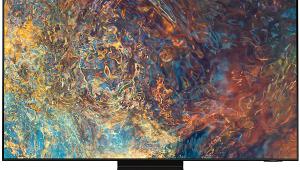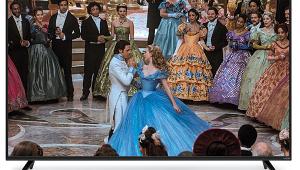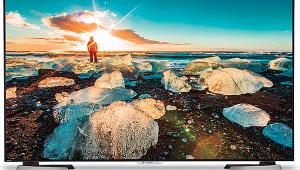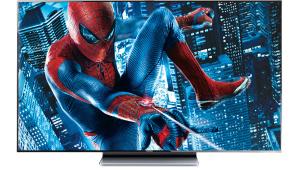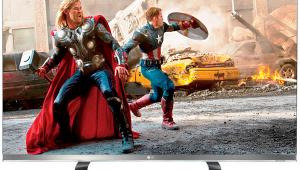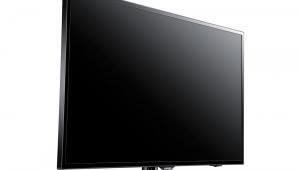Toshiba Cinema Series Pro 47LZ196 LCD Flat Panel

LCD is also ahead of plasma in one key respect- while 1080p pixel density is just now appearing on some very expensive plasmas, 1080p is becoming de rigeur at upper-mid level prices and even creeping closer to the bargain prices in some cases.
Toshiba is into LCD flat panels in both of its top tier lines, Cinema Series and Cinema Series Pro. And the subject of this review is the 47" Cinema Series Pro 47LZ196, which at $3,899 is essentially a premium 1080p model at a premium price.
Form and Features
Compared to its Cinema Series stable mate the 47LZ196 costs only $300 more and sports upgraded gloss black styling as well as some key features. The sets from both lines are 1080p, but only the Cinema Series Pro rig accepts native 1080p signals. In addition, although the sets from both lines feature CableCARD HD tuners, the Pro line set adds over-the-air, as well as QAM HD tuners. Also, the Pro set has functionality that allows you to check email on-screen if ya need it.
Like Toshiba's other sets, a THINC port Ethernet jack is connected and supports a variety of networking features that we won't evaluate here. You can view photos, stream music and more.
Physically the set includes a swiveling tabletop stand, which reveals the flat panel's dirty secret- most people plant them on tables or stands and not on the wall. Dual HDMI and component inputs are included, and I used the former almost exclusively. The jack pack is up on the back of the set, and an oddity is that the HDMI inputs are numbered 1 and 2, but when you select them in the on-screen menus they're inputs 5 and 6, respectively.
The Toshiba has separate memories for each input, but whenever you enter your own adjustments from one of the preset modes, those settings now become your personal Preference mode. The only problem is that if someone else uses a different mode, such as the hideously overblown Vivid mode, and then makes a single change that becomes the new Preference for that input and your dialed settings are gone daddy, gone. Take some advice from Tom Norton: write your Preference settings down and keep that piece of paper somewhere safe! (We've been complaining about the volatile nature of the Preference menu in Toshiba sets for 10 years!—TJN)
Aside from the usual suspects of adjustment (brightness, contrast, etc.) this Toshiba LCD has some other features worth noting. The brightness of Toshiba's backlight can be controlled from in the user menu. An adjustable backlight is becoming more common in such displays, but is not yet universal. (All flat panel LCD displays are illuminated by a backlight, usually a cold cathode fluorescent.)
There are two Noise Reduction circuits, an overall DNR and an MPEG Noise reduction. These were both subtle, with scarcely visible plusses or minuses, and I ended up with the former in its default "Auto" position and MPEG at low.
The Color Management Pro system here is not included in the Cinema Series sets and is an example of a manufacturer spending a lot of energy, and perhaps money (theirs and yours if you buy the set) to give you control over something you shouldn't want and don't need. Toshiba isn't alone in this, and I am not picking on it specifically. In my opinion manufacturers should spend their resources and your money making their displays conform to the new HD standards for primary and secondary color points, and if they really want to go nuts, do SMPTE C too since there are still a lot of post-production facilities that master program material to that standard.
But allowing users without instruments to arbitrarily tweak colors in 90 different ways isn't a benefit that I can see. The color adjustment suites I've seen have seldom, if ever, allowed the user to dial in more accurate color points. The set should simply reproduce the color palette of the known standards first and foremost, and if you want to let people turn their picture into cartoons in addition to that, so be it. But do the right thing first and drop the superfluous features. OK, I'm off my soapbox and ready to continue now.
The Advanced Picture Settings menu has a Dynamic Contrast feature that adjusts the contrast of the image dynamically according to the program material. At the Low setting I found this feature helpful- it subjectively darkened blacks without crushing detail and made the picture look snappier with better perceived contrast and less LCD haze (more on that later). But when increased to its Mid setting it made blacks look better at the expense of making the image look too dim.
A seemingly related feature here is Static Gamma, which according to the user manual either increases or decreases the "detail of black colors" (I've always thought of black as a single color, not plural, but whatever). Static gamma seemed to work like Dynamic Contrast but without changing from scene to scene depending on program material, and its steps didn't seem to make quite as dramatic an impact as engaging Dynamic Contrast. After experimenting I found that I liked the picture best with the Dynamic Contrast turned off, and the Static Gamma at –2 or –3, but I also found Static Gamma at 0 and Dynamic Contrast at Low to be a close second. In addition, there is a Vertical Edge Enhancer feature whose enhancements I couldn't detect and left Off.
The Advanced menu is also where the Color Temp Selection lives. Warm was the lesser evil. But even this setting, with its noticeable out of the box color tint, was not acceptable to me. Although blue and red drive adjustments are accessible in the user menu, this set unequivocally needs a pro ISF calibration to look its best.
There is an acceptable speaker system on board, which is a chore for a flat panel that isn't even 4" deep. I didn't test it because I assume if you're reading UAV you won't be using it for serious listening. There are many menu and user manual pages devoted to the use of these and many other convenience features that I'll leave to you, if you wish.
On the usability front some long time Toshiba quirks remain. For one, there is no direct access to source inputs. The quickest route is hitting the remote's Input button, and then the number assigned to the source you want on the keypad. Better than cycling through the inputs, but only marginally so. Aspect ratios, called Pic Size here, must be cycled through, and none of this would be so frustrating if the remote weren't littered with tons of buttons that are far less useful than direct access to functions used more often. The remote isn't ergonomically bad, it's just that some of Toshiba's decisions about what to include there, and what to omit, are head scratchers.
Picture Performance
With this set I used my DirecTV HD TiVo as a source for standard and HD programming, Toshiba's HD-XA1 HD DVD player for DVD and HD DVD, and I spun (gasp!) some Blu-ray from Samsung's BD-P1000 (firmware updated) and Sony's PlayStation3 Blu-ray Disc players.
The Toshiba produced a very clean, noise free image with virtually all sources. There were times when it looked simply pristine in this regard. The set also consistently exhibited natural edges and a very respectable sense of depth, especially with the best HD material from HD DVD and, yes, Blu-ray.
The color palette of this set looked terrific with the single exception of a green that looked a little too yellow for me, making grass and other foliage appear a little lighter than life. It was far from the nuclear limes that plague many other sets though, so I consider this more of a nit-picky observation than a genuine criticism. In general I thought the colors were pleasingly natural.
Like every other LCD I've seen this one couldn't make deep blacks that compete with the better plasmas during dark movie scenes, but like only a few of the most recent vintages this one did eliminate the false contouring, posterization and noise that used to come along with the hazy blacks. It gets hazy, but it doesn't ever lose its composure and compound the issue by getting noisy or nasty, even during torture test dark scenes.
While LCDs are known to be very bright and punchy, I did not find that I could raise this Toshiba's Backlight or Contrast controls to a level that brought high light output without the high black level that came with it, making the image look too washed out for my tastes. Keep in mind that I prioritize watching movies in a darkened room above all other viewing. Mid-brightness level scenes had something of a murky look to them just a little to often for my tastes.
Also, while 1080p on a screen this size can be awesome, my impression was that this set is a bit soft with the best 1080i/p HD. This impression was confirmed by measurements, which revealed a noticeable rolloff in the highest frequencies in HD test patterns. Combined with the low-ish light output and the occasional haze from LCD's inherently poor blacks and I was reminded of the display technology more often than I wanted to be during movie and TV viewing.
I did occasionally see something resembling motion blur. I say, "resembled" because this was nothing like the psychedelic trails early LCDs exhibited with motion. Occasionally I did see an unnatural quality with motion, but it was subtle enough that it could involve something with the video processing and not be related to the panel's response time at all.
Conclusions
Toshiba's 47LZ196 goes far at mitigating or even downright eliminating a number of LCD's inherent performance foibles. In particular, I was struck by how clean and noise free this set looked, even during very dark movie sequences, and I also liked this set's color palette which is a substantial cut above many flat panels I've seen.
But as a dedicated and avid movie watcher who is going to drop the lights and watch a movie 9 out of 10 times his TV is fired up, the best LCD flat panels I've seen are still not at the same level for this type of viewing as the best plasmas. And while this Toshiba is long strides beyond the early LCDs, I just couldn't get around the lack of contrast during many movie scenes and was also put off by the softness I saw with my best HD sources. While viewers who prioritize more casual TV watching might feel differently, for me, this is not quite enough to get a pass at the premium price level in this size and category.
Highs
Clean, noise-free picture
Lack of artifacts at or around black
Pleasing, natural color palette
Lows
Soft picture with HD
High-ish blacks and compromised contrast ratio
